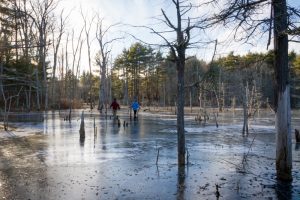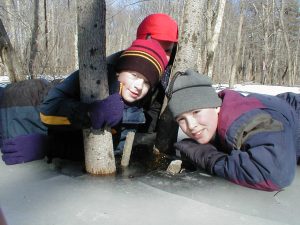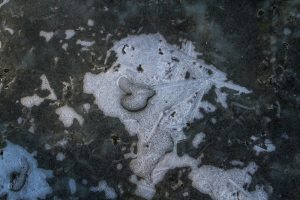Water Closet for December 30, 2016
Ice is back as it should be in December. On Friday, 16 December, the early morning temperature was 0° F; the flags on a fair northwest wind in front of St. Agnes Church, the old Closeteer’s wind gauge, were straight out. [pullquote]”Even those of us who are very familiar with ice have gone through. Don’t go testing ice alone. “[/pullquote]TV weathermen excitedly said the wind chill was -15 F. The Council on Aging/Conservation Commission Friday morning walkers cancelled their hike.

Middleton Stream Teamers and guests crossing Prichards Pond on a foot of ice in 2005. – Stream Team photo
Some Stream Teamers, who have never given snow birding to Florida a thought, think such weather is not only cold but “cool.” The water molecules are “chilling” as they lose their kinetic energy. At 32 F their dance is so slow they cling to one another and become a vast solid of called ice. As the air above becomes ever colder the heat in the still unfrozen water below the new ice on the surface loses heat. Remember from your high school physics and chemistry that heat flows from higher to lower temperatures? If you don’t, step outside for a moment and feel what happens.

Two hikers are walking on the ice of a beaver impoundment among the trunks of drowned red maples. – Judy Schneider photo
One of the reasons that Stream Teamers, lovers of water bodies, like cold and the resulting ice is the access it gives to beaver impoundments, lakes, ponds, and other water bodies not to be explored on foot. A week of day long freezing air allows us out on Emerson Bog, Aunt Betts Pond and surrounds, the beaver impoundments under the Pond Meadow Pond Rookery, the southwest Middleton Pond Rookery, the upper Cudhea Crick impoundment, and a dozen other places under water in Middleton. If foolhardy some might after long cold snaps venture out on the Ipswich River. The winter of 2014-2015 was infamous to DPWs and wonderful for us ice walkers who ventured out on the tricky ice of Nichols Brook’s broad floodplain between Topsfield and Middleton. DON’T TAKE ANY CHANCES. Even those of us who are very familiar with ice have gone through. Don’t go testing ice alone.

Three peeping Toms looking though a window of black ice around a tree trunk. An underworld of liquid water above freezing temperature is revealed. – Katharine Brown photo
En route on safe ice we look for places with black ice. Black ice, not black at all, is transparent. Muddy bottoms absorb light and don’t reflect much back. White and gray ice full of tiny bubbles does. Upon encountering patches of transparent ice lie down and peer into the liquid water below. You may be surprised at the activity you see in 32 F water. We’ll not explain further. Go look. Black ice is often seen around the inundated bases of tree trunks where the water is last to freeze. The sunlight absorbed by the trunk keeps the water next to it warmer. Even after intense periods of cold you might find halos of liquid water around trunks.
Most all substances upon cooling become steadily denser. Water is an exception. At 39 F, as bonds between the molecules form, it becomes less dense until at 32 F when it follows the usual pattern again of increasing density as the temperature continues to drop. However, since less dense than liquid water ice floats. If it was denser you’d need SCUBA gear and a good wet suit to skate on the frozen bottom.

Mother Nature’s art using a black and white ice medium. Can you find a head as well as a heart? – Judy Schneider photo
Why is ice less dense? Let’s imagine the water molecules dancing individually as their surroundings cool. They slow and get closer, attracted by each other and at 39 F start to form bonds. The tired dancers are going from a frenetic jitterbug to a waltz. By 32 F even if shy they cling to one another but in a formal way arms extended. Another way looking at this might be to envision a rugby scrum at 39 F when the players are ordered out of the scrum into formation, one arm forward to another’s shoulder the other sideways to another. By 32 F all are so bonded with spaces now between them so the solid formed in less dense. The extended arms represent chemical bonds. H-O-H — H-O-H — H-O-H — etc. where the –s represents bonds between the H2O molecules. The vast crystalline solid formed is called ice. The energy lost in the freezing process is about 80 cal/g or about that energy in baby’s bite of toast. This amount of energy is called the heat of fusion. A gram of ice has about 1/18 x 6.023 x 1023 molecules. If you want to see that number written out with all its zeros write .33 followed by 23 zeros. Now of course you want know how this enormous number was determined. Go on line and look up Avogadro’s number. The explanation is extremely elegant.
Let’s leave that research for another day and go check the ice. BE CAREFUL. The temperature as of this writing has been below freezing for the last few days. 40 F is predicted for tomorrow. The ice receiving the right amount of heat will melt to free
jitterbugging molecules.
____________________________________________________________
WATER RESOURCE AND CONSERVATION INFORMATION
FOR MIDDLETON, BOXFORD AND TOPSFIELD
| Precipitation Data* for Month of: | Sep | Oct | Nov | Dec | |
| 30 Year Normal (1981 – 2010) Inches | 3.77 | 4.40 | 4.55 | 4.12 | |
| 2016 Central Watershed Actual | 1.85 | 6.81 | 4.1** | 2.6**as of Dec 23 | |
Ipswich R. Flow Rate (S. Middleton USGS Gage) in Cubic Feet/ Second (CFS):
For Dec 23, 2016 Normal . . . 60 CFS Current Rate . . .35 CFS
————————————————————
*Danvers Water Filtration Plant, Lake Street, Middleton is the source for actual precipitation data thru Oct.
** Middleton Stream Team is the source of actual precipitation data for Nov and Dec.
Normals data is from the National Climatic Data Center.
THE WATER CLOSET is provided by the Middleton Stream Team: www.middletonstreamteam.org or <MSTMiddletonMA@gmail.com>

m 8 win hello my website is m 8 win
tegen hello my website is tegen
wizzy hello my website is wizzy
vtv5 hello my website is vtv5
mpoif hello my website is mpoif
Elt NTT hello my website is Elt NTT
patatap hello my website is patatap
grenbet hello my website is grenbet
jsEncrypt hello my website is jsEncrypt